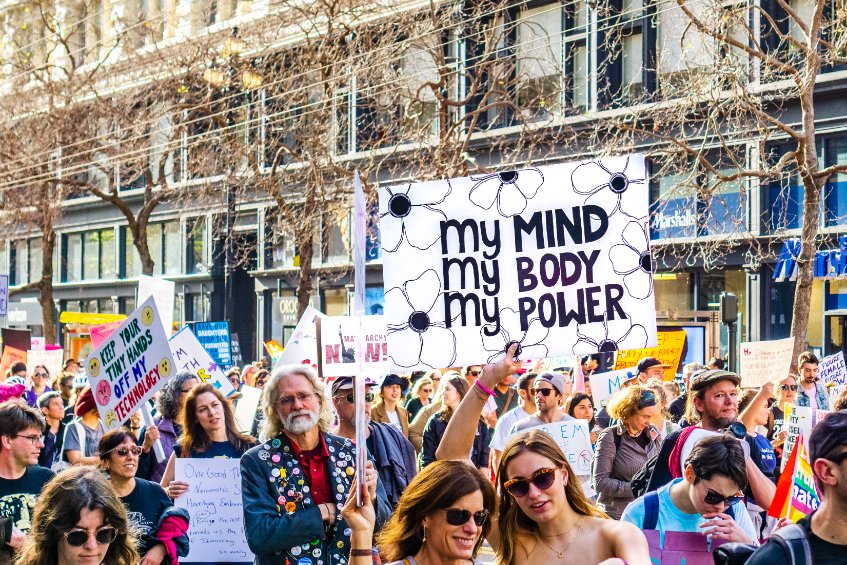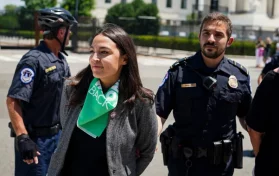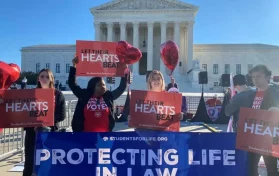
Soon after the Supreme Court handed down its ruling on Roe v. Wade on Friday morning, protests erupted across the nation. American flags were burned in some locales, but in other locations, protests had to be controlled by local authorities. Pro-life activists showed up in some areas, as did pro-choice protestors.
This morning, in front of the Supreme Court building, both pro-life and pro-choice protestors are gathered. Live reports show some protestors shouting down one another. There have been a few flag-burning incidents, but most protests have been largely peaceful.
There are also protestors outside the homes of some of the Supreme Court Justices.
Authorities were not surprised by the presence of protestors and activists. Prior to the ruling announcement, the DC police and the Capitol Police had beefed up their presence in anticipation of violent protests.
Many major American cities saw protests during the day on Friday, but, in some areas, protests overnight were dispersed by authorities. In Arizona, tear gas was utilized to end one protest at the state capitol building.
In Washington, D.C., protestors arrived Friday morning outside the Justice building; they are from both sides of the abortion argument. Most of them had signs and vocally protested. Representative Alexandria Ocasio-Cortez joined pro-choice protestors on Friday.
Not only did AOC speak to the crowd, but she also joined in chants regarding the legitimacy of the Court. Rep. Maxine Waters also spoke to the crowd, where she said, “To hell with the Supreme Court! We will defy them.” Waters and Ocasio-Cortez were among several Democrat Congresspeople who gathered with protestors outside the Supreme Court building.
Protestors in the southwestern portion of the city burned flags and carried signs that used obscenities when mentioning the conservative Justices of the Court.
It’s noteworthy that D.C. abortion regulations allow for abortion in both the second and third trimesters.
At least 17,000 demonstrators gathered in New York City to protest the ruling. Democratic Governor Kathy Hochul has recently signed legislation that would “expand protections” for both abortion providers in her state and abortion patients ahead of the Friday ruling. New York’s state law includes a 2019 Reproductive Health Act.
While protests in the Hollywood and West Hollywood area of Los Angeles County were largely peaceful, one crowd in downtown Los Angeles had to be dispersed due to what officials dubbed an “unlawful assembly.” Reports hold there may have been some violence between police and protestors there, with protestors alleged to have set off fireworks and thrown rocks during the assembly. SWAT teams utilized non-lethal bullets to disperse the crowd.
Otherwise, some protestors walked along the freeway, blocking rush hour traffic.
On Friday, California Governor Gavin Newsom signed a bill that would protect both patients and abortion providers in California “from other states’ restrictions.”
In parts of the Windy City, streets were closed when protests broke out near Chicago’s Federal Plaza. Illinois had already set protections for women seeking an abortion before the ruling came down on Friday.
Arizona, however, saw some violent protests, with gatherings near the state capitol build ending with local law enforcement using tear gas to disperse the crowd.
One person was arrested during the protests in Phoenix, and reports hold that “multiple Senate doors and memorials have been damaged in the protests.” At least 8,000 people gathered at the Capitol. Law enforcement had already decried the protests as unlawful and attempted to disperse protestors before the event began. However, they simply moved to the state Senate building to carry out their demonstrations.
Arizona has a law already on the books that makes performing an abortion between two and five years of imprisonment. However, in March, Governor Doug Ducey signed a law that prohibits abortion after fifteen weeks’ gestation, except when the mother’s life is in danger. Otherwise, a performing physician could lose their license to practice medicine as well as receive felony charges.
Protests also took place in Austin, Texas; St. Louis, Missouri; Atlanta, Georgia; and Boston, Massachusetts.





